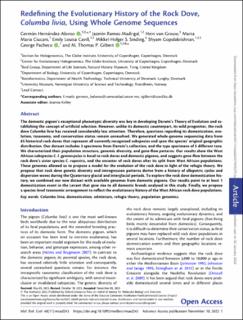| dc.contributor.author | Hernández-Alonso, Germán | |
| dc.contributor.author | Ramos-Madrigal, Jazmín | |
| dc.contributor.author | van Grouw, Hein | |
| dc.contributor.author | Ciucani, MartaMaria | |
| dc.contributor.author | Cavill, Emily Louisa | |
| dc.contributor.author | Sinding, Mikkel-Holger S. | |
| dc.contributor.author | Gopalakrishnan, Shyam | |
| dc.contributor.author | Pacheco, George | |
| dc.contributor.author | Gilbert, Marcus Thomas Pius | |
| dc.date.accessioned | 2024-01-03T12:34:09Z | |
| dc.date.available | 2024-01-03T12:34:09Z | |
| dc.date.created | 2023-12-18T09:31:55Z | |
| dc.date.issued | 2023 | |
| dc.identifier.issn | 0737-4038 | |
| dc.identifier.uri | https://hdl.handle.net/11250/3109551 | |
| dc.description.abstract | The domestic pigeon's exceptional phenotypic diversity was key in developing Darwin's Theory of Evolution and establishing the concept of artificial selection. However, unlike its domestic counterpart, its wild progenitor, the rock dove Columba livia has received considerably less attention. Therefore, questions regarding its domestication, evolution, taxonomy, and conservation status remain unresolved. We generated whole-genome sequencing data from 65 historical rock doves that represent all currently recognized subspecies and span the species’ original geographic distribution. Our dataset includes 3 specimens from Darwin's collection, and the type specimens of 5 different taxa. We characterized their population structure, genomic diversity, and gene-flow patterns. Our results show the West African subspecies C. l. gymnocyclus is basal to rock doves and domestic pigeons, and suggests gene-flow between the rock dove's sister species C. rupestris, and the ancestor of rock doves after its split from West African populations. These genomes allowed us to propose a model for the evolution of the rock dove in light of the refugia theory. We propose that rock dove genetic diversity and introgression patterns derive from a history of allopatric cycles and dispersion waves during the Quaternary glacial and interglacial periods. To explore the rock dove domestication history, we combined our new dataset with available genomes from domestic pigeons. Our results point to at least 1 domestication event in the Levant that gave rise to all domestic breeds analysed in this study. Finally, we propose a species-level taxonomic arrangement to reflect the evolutionary history of the West African rock dove populations. | en_US |
| dc.language.iso | eng | en_US |
| dc.publisher | Oxford University Press | en_US |
| dc.rights | Navngivelse-Ikkekommersiell 4.0 Internasjonal | * |
| dc.rights.uri | http://creativecommons.org/licenses/by-nc/4.0/deed.no | * |
| dc.title | Redefining the Evolutionary History of the Rock Dove, Columba livia, Using Whole Genome Sequences | en_US |
| dc.title.alternative | Redefining the Evolutionary History of the Rock Dove, Columba livia, Using Whole Genome Sequences | en_US |
| dc.type | Peer reviewed | en_US |
| dc.type | Journal article | en_US |
| dc.description.version | publishedVersion | en_US |
| dc.source.volume | 40 | en_US |
| dc.source.journal | Molecular Biology and Evolution (MBE) | en_US |
| dc.source.issue | 11 | en_US |
| dc.identifier.doi | 10.1093/molbev/msad243 | |
| dc.identifier.cristin | 2214647 | |
| cristin.ispublished | true | |
| cristin.fulltext | original | |
| cristin.qualitycode | 2 | |

